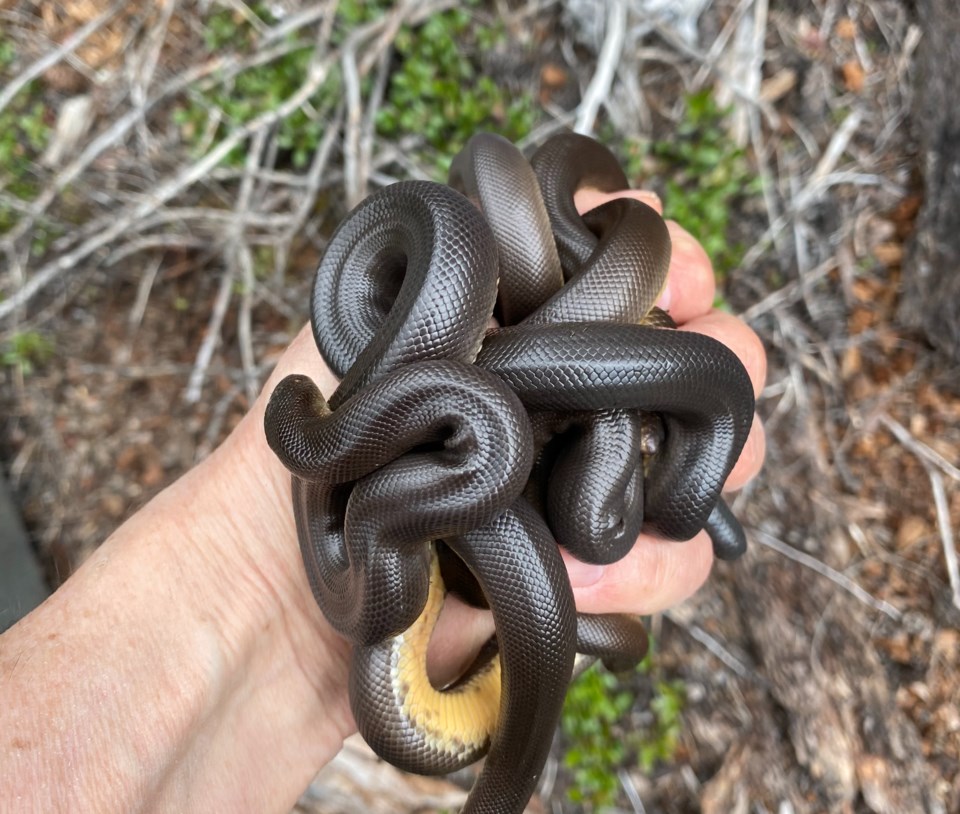Whistlerites look forward to many things in spring: biking, golf, restaurant specials—maybe even some soft, buttery turns on the mountain. I’m down with most of those as well, but the biologist in me tends to laser-focus on one thing as winter winks out: snakes. Until I see one, spring hasn’t really arrived. Even then, sighting one of the Lower Mainland’s trio of colourful gartersnakes—Valley, Wandering, Northwestern—won’t really cut it. No, in order to truly believe the vernal maiden has arrived, I need to see a Northern Rubber Boa.
Nature-minded people will eagerly continue reading to learn something of one of the least understood—and most threatened—animal groups worldwide. Others will stop here or at least want to. But even some of those folks will continue on for the same reason we scan news about airline crashes and tsunamis: our fascination with low-probability threats overrules our fear of them. Except there’s really nothing to fear here. Eight of B.C.’s nine snake species are completely harmless, and, while the Northern Pacific Rattlesnake packs a venomous bite, avoiding it is far easier than avoiding the danger of wasps or even bears. Snakes are really only a threat to the small critters they feed on, which accounts for their importance in transferring energy from aquatic to terrestrial environments (by eating fish and amphibians) and major control of invertebrate and rodent populations—the latter a de facto ecological service to farmers.
A quick digression: Snakes date to the Jurassic period, ~150 million years ago. Though understood to have evolved through limb-reduction in an ancient lizard lineage, it’s unknown whether this was originally an aquatic or terrestrial adaptation, adding to the many mysteries about snakes. There may even be a snake tie-in to our own origins. Some anthropologists believe the high visual acuity acquired by our primate ancestors evolved to detect the strike of a snake in arboreal habitats. Meaning we might have snakes to thank for the ability to see a frisbee or ball approaching in our peripheral vision. Given the worldwide decline of these animals due to habitat destruction, persecution and the inevitable attrition of increased development, seeing them in the wild is a special opportunity.
For those sketched-out by snakes, the impressively docile, almost toy-like Rubber Boa might be the ticket out of your own personal Fear Factor. This olive- to chocolate-brown animal whose name derives from its playdough appearance is people friendly: it’s small (adults rarely exceed 70 cm), slow-moving (people tend to be freaked out by other snakes’ jerky, frantic movements), and it never, ever bites. It’s also ancient (males sport vestiges of rear limbs in the form of tiny spurs used for tickling females); crepuscular and nocturnal (with cat-like vertical pupils to match); semi-fossorial in habit (spends a lot of time underground); long-lived (up to 70 years!); and engages in several fascinating behaviours.
The first of these behaviours has to do with defense against larger predators: like most snakes, Rubber Boas release a fetid combination of feces, uric acid and anal musk when disturbed. If that doesn’t do the trick, the snake might flatten into a coil and flash a bright yellow belly as a sort of warning. If all else fails they contract into a ball with head buried in the centre and the blunt, nondescript tail sticking out. As a result, it has been nicknamed the “two-headed snake.”
This last posture has further utility in the boa’s pursuit of food. Curling through the netherworld beneath leaves, logs and rocks, it seeks out rodent nests, preferentially inhaling babies (aka “pinkies”); when it happens upon a nest and starts to devour the helpless young, it keeps frantic mama rodent at bay by fooling her into thinking its tail is its head, which she then attacks. As a result, the tail of older boas is often heavily scarred by the slashes of rodent teeth.
Rubber boas hibernate in hillside dens and transit to valley bottoms in summer in search of food. Females give birth to one to four live young every few years, and often hang around their winter den-site until the young are born in August.
While all of British Columbia’s snakes reach the northern limit of their continental ranges in the province, all save the Valley Gartersnake (which brushes the Yukon border) populate the southern tier, discontinuously distributed due to the labyrinthine nature of B.C.’s mountainous geography—an apt description of the Rubber Boa’s small, isolated populations. Though rarely seen, they’re common throughout the Pemberton Valley, north to the Upper Lillooet and into the Interior. Closer to Whistler, they’re known from Rutherford Creek to the north (my records), and Chance Creek to the south (iNat). Given the boa’s occurrence on both sides of town there should be isolated pockets here as well, and years ago people gave convincing descriptions of sightings in the Lost Lake trails and Emerald areas. It’s also rumoured BC Parks employees found a few near the Wedge trailhead into Garibaldi Park back in the 1970s.
I have yet to find any in my wanderings around Whistler’s wild areas (but if you do please tell me!), so my spring urges are sated through bio-inventory and conservation work at dens in the Pemberton area, where there’s usually more than one snake. Meaning, what I really should have said is that it’s not truly spring until I’ve seen a fistful of boas.
Leslie Anthony is a biologist, writer and author of several popular books on environmental science.




